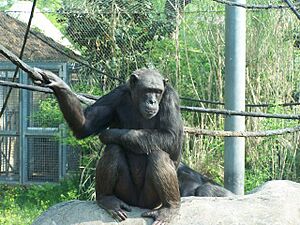Chattanooga Zoo at Warner Park facts for kids
| Date opened | 1937 |
|---|---|
| Location | Warner Park, Chattanooga, Tennessee, Tennessee |
| Land area | 13 acres (5.3 ha) |
| Coordinates | 35°02′35″N 85°16′58″W / 35.0431°N 85.2829°W |
| No. of animals | 860 (2012) |
| No. of species | 148 (2012) |
| Annual visitors | 150,095 (2012) |
| Memberships | Association of Zoos and Aquariums |
| Major exhibits | Himalayan Passage, Gombe Forest, Corcovado Jungle, Walkin' the Tracks, Warner Park Ranch, Deserts of the World, Forests of the World, and Makazi Ya Twiga |
The Chattanooga Zoo is a fun place to visit in Chattanooga, Tennessee. It's a zoo that covers 13 acres of land. The zoo first opened in 1937. It started small, with just two cages for rhesus monkeys.
Since 1998, the zoo has been approved by the Association of Zoos and Aquariums (AZA). This means it meets high standards for animal care.
Contents
Explore the Zoo's Amazing Exhibits
The Chattanooga Zoo has many cool areas to explore. Each area is like visiting a different part of the world. You can see animals from mountains, jungles, and deserts.
Himalayan Passage: Home of Red Pandas
The Himalayan Passage is a very special exhibit. It is home to the zoo's red pandas. This exhibit has the largest indoor red panda area in the world. This is amazing because the Chattanooga Zoo is one of the smaller zoos approved by the AZA.
In 2006, the Himalayan Passage grew even bigger. It added new homes for snow leopards and Hanuman langurs. Later, white-cheeked gibbons moved into this area in 2019.
Gombe Forest: Meet the Chimpanzees
The Gombe Forest is a large exhibit for the zoo's chimpanzees. It cost $2.1 million to build and opened in 2001. This area has both indoor and outdoor spaces for the chimps.
One famous chimpanzee named Hank lived here for a long time. Hank was found in Africa in 1968. He came to the zoo in 1976. Hank was the zoo's most famous resident until he passed away in 2011 at 42 years old. The Donovan Interpretive Center lets you watch the chimpanzees indoors. It also has other small exhibits.
Corcovado Jungle: Animals from Latin America
The Corcovado Jungle is where you can find animals from Latin America. This includes amazing creatures like jaguars, spider monkeys, and colorful macaws. You can also see capybaras, kinkajous, and prehensile-tailed porcupines.
The La Selva Amazonica pavilion is part of this area. It houses four different kinds of tamarins. You can also spot Geoffrey's marmosets there.
Deserts and Forests of the World
In the Deserts and Forests of the World buildings, you'll find animals that live in dry or wooded places. Look for desert dwellers like fennec foxes, meerkats, and the sand cat. You can also see forest animals, including amazing komodo dragons.
Walkin' the Tracks: North American Animals
Walkin' the Tracks features animals from North America. This exhibit has bobcats, prairie dogs, and white-tailed deer. The area is designed to look like a railroad. This is a nod to Chattanooga's history with trains. The Cougar Express lets you view the zoo's cougars from inside a train car.
Warner Park Ranch: Farm and Friendly Animals
The Warner Park Ranch is home to some larger and more gentle animals. Here you can see camels, pot-bellied pigs, and miniature horses. There are also alpacas and a shaggy Highland cattle. The petting zoo part of the ranch has different kinds of goats. Guests are allowed to gently pet these friendly goats.
Makazi Ya Twiga: Giraffes Reach New Heights
In May 2020, the zoo welcomed three male reticulated giraffes. They live in the Makazi Ya Twiga exhibit. This exhibit was the first part of the zoo's "Reaching Great Heights" expansion plan. Later, the zoo also added blue duikers to an indoor exhibit.
Zoo Facilities
A new main entrance opened in 2008. It includes new parking areas and a gift shop. There are also restrooms and a place to buy snacks. A fun carousel with endangered species is also part of the entrance area.
The zoo also helps wild animals that are hurt or sick. It has a facility that treats these animals. Once they are better, they are moved to another local animal care center.
Helping Animals: Conservation Efforts
The Chattanooga Zoo works hard to protect animals. They are part of the AZA's Species Survival Plan. This plan helps manage breeding programs for endangered species. It also works to keep these animals healthy in zoos across North America.
The zoo has teamed up with other groups for important projects. They work with the Lincoln Park Zoo on the Argentine Jaguar Conservation Project. They also partner with Lee University for the Hellbender Conservation Program. Since 1998, the zoo has worked with the Zoo Conservation Outreach Group (ZCOG). ZCOG helps zoos in Latin America. They support efforts to save the Amazon Rainforest.
The Zoo's Future Plans
The Chattanooga Zoo is always growing and improving. It is currently working on a big plan that costs $12 million. This plan will make the zoo even better. In the last 10 years, the zoo has grown from 1.5 acres to its current 13 acres. The plan includes new exhibits and more animals. Some of the new animals include African penguins and more gibbons.


